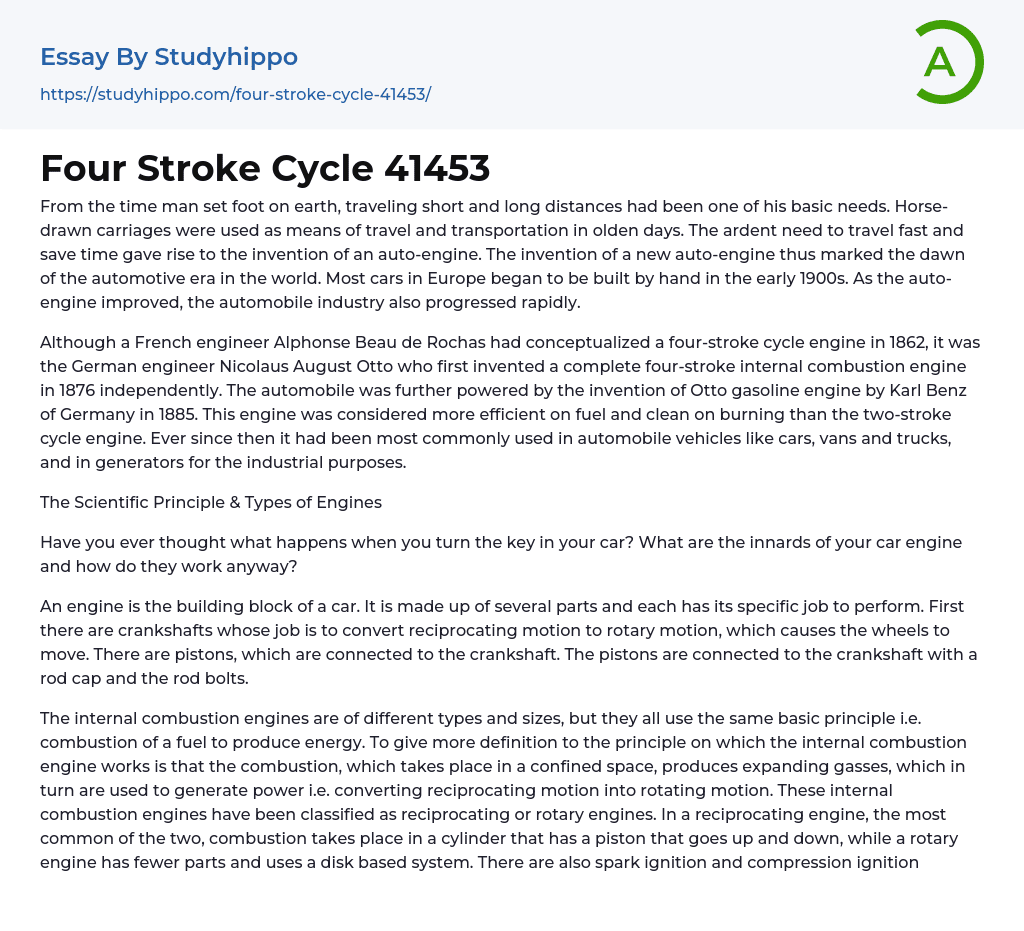Throughout history, humans have had the need to travel both short and long distances. In earlier times, horse-drawn carriages were used as a mode of transportation. However, as the desire for quicker travel and more efficient solutions grew, the auto-engine was developed. This revolutionary invention marked the start of the global automotive era. In Europe in the early 1900s, advancements in auto-engine technology drove forward the automobile industry, resulting in a rise in hand-built cars.
Although Alphonse Beau de Rochas, a French engineer, conceptualized a four-stroke cycle engine in 1862, it was the German engineer Nicolaus August Otto who independently invented a complete four-stroke internal combustion engine in 1876. Furthermore, the invention of the Otto gasoline engine by Karl Benz of Germany in 1885 further enhanced the power of automobiles. This engine was more fuel-efficient and had cleaner burning
...compared to the two-stroke cycle engine. Since then, it has become the most commonly used engine in vehicles such as cars, vans, and trucks, as well as in generators for industrial purposes.
The Scientific Principle and Different Types of Engines
Have you ever wondered what goes on inside your car's engine when you turn the key?
A car's engine contains various components that function separately but collaboratively to form the fundamental structure. The crankshaft plays a vital role by transforming back-and-forth motion into rotational motion, allowing the wheels to rotate. Furthermore, the piston is an integral part that connects to the crankshaft through a rod cap and rod bolts.
All types and sizes of internal combustion engines operate on the same basic principle: fuel is combusted to create energy. This principle involves combustion happening in a confined space, resulting in expanding
gases used to generate power by converting reciprocating motion into rotating motion. These engines can be categorized as either reciprocating or rotary engines. Reciprocating engines are more common and have combustion occurring in a cylinder with a moving piston. In contrast, rotary engines have fewer parts and utilize a disk-based system. Moreover, there are two kinds of internal combustion engines: spark ignition and compression ignition.
Comprehending the Four Stroke Cycle
The Four Stroke Cycle is commonly utilized in internal combustion engines for automotive and industrial applications. It encompasses various piston movements. In a four-stroke engine, each piston undergoes four movements: downward, upward, downward, and upward. The initial downward movement allows air to enter the cylinder, followed by an upward movement for compression. The subsequent downward movement represents the power stroke, while the second upward movement expels the gases generated during combustion. This engine type necessitates exhaust and air-intake valves. The Otto cycle employs four strokes or piston movements within a cylinder to complete one combustion cycle in a piston engine. These strokes include:
1. The Intake Stroke, also known as the Induction Stroke.
2. During the compression stroke, the volume inside the cylinder decreases.
The Combustion Stroke refers to the Ignition, Power, or Expansion Stroke.
4. The Exhaust Stroke
The four-stroke cycle begins when the piston reaches its highest point. During the first downward stroke, a mixture of fuel and air enters the cylinder through the inlet valve, which then closes. The second upward stroke compresses the fuel-air mixture within the cylinder. This mixture is ignited near the top of the compression stroke, usually by spark plugs in a gasoline or Otto cycle engine. The ignition causes an explosion in the burning
gases, pushing the piston down for the third stroke, also known as the power stroke.
The fourth upward stroke, known as the Exhaust Stroke, expels burned gases from the cylinder through an open exhaust valve and out via an exhaust pipe. In a piston engine, each piston must move back and forth twice and pause four times to complete one cycle. A piston engine produces one power stroke every other time a piston moves down its cylinder.
Comparison between Gasoline Engine and Diesel Engine
Rudolph Diesel, a German engineer, invented the diesel engine in 1892. This engine is specifically designed for heavy-duty tasks and is well-known for its superior power compared to gasoline engines. It functions by using oil as its fuel source. Diesel engines are commonly used in heavy machinery, locomotives, ships, as well as vehicles like tractors, large buses, and massive freight trucks for heavy road-building equipment.
There are two main variations of diesel engines: the four-stroke engine and the two-stroke engine. The distinguishing factors between these types lie in the number of piston strokes required to complete a cycle that includes fresh-air intake, air compression, power generation, and exhaust release.
The Gasoline Engine and Diesel Engine differ in their ignition methods. The diesel engine utilizes compression-ignition, where air is compressed in the cylinders to raise temperature. Fuel is then injected into the hot, compressed air and ignites explosively. In contrast, the gasoline engine relies on a spark plug located at the top of the compression stroke for ignition. Consequently, the main difference between these engines lies in their respective ignition processes.
- Renault essays
- Truck essays
- chrysler essays
- The city essays
- Racing essays
- Bicycle essays
- Cars essays
- Rms Titanic essays
- Cycle essays
- Shape essays
- Automobile essays
- Bus essays
- Civil engineering essays
- Cycling essays
- Electric Car essays
- Genetic Engineering essays
- Hybrid essays
- Innovation essays
- Internal Combustion Engine essays
- Invention essays
- Mechanical Engineering essays
- Mechanics essays
- Software Engineering essays
- Telephone essays




